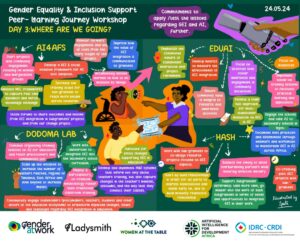By Mario Chávez Claros
Editors’ note: Rarely do we have the opportunity to learn about how individual researchers come to understand the importance of carrying out gender analysis. In the fourth blog of our 12 blog series, Walking the Talk: Think Tanks & Gender, Mario Chávez Claros, tells the story of this personal journey.
–
Six years ago, when I was 25 years old, I had the chance to start working as a researcher at the center for research and statistics in the Salvadoran Foundation for Economic and Social Development (FUSADES).
One of the first projects I got to work on was a study on public transport crime. I remembered having no idea what to do or were to start, and even had second thoughts about it, but with help of my co-workers and the guidance of experts, we started research that would change the way I work and how I see things around me.
During that time, I learned about qualitative analysis and the importance of disaggregated data. The results of the research were somehow predictable but one aspect of it was shocking. While most people said the experience of riding a bus was chaotic and insecure, something unexpected popped up. All female participants said they experienced some kind of sexual harassment.
These results especially surprised me. I guess as a man I am not usually aware of all the problems women have to face, so I expected common crimes such as robbery or thefts to appear in the result as the main issue to be resolved.
When we presented the results of the study to different audiences, all women agreed and related to this finding. For most people this research topic was relevant because there was no data about it.
At that time FUSADES had started a new women´s initiative within the organization. This effort took the study to a new level. It became a model for other initiatives and research. For example, it promoted that all studies in FUSADES should include a gender approach in their analysis, highlighting the importance of gender differences; it also helped use the lessons and methodology from the study and apply it to other research areas.
While participating in this study, I had the chance to see how public institutions, the private sector, and many other actors identified so strongly with the results. Most people recognized the problem of sexual harassment as a daily problem women have to face while riding the bus. At some point I was really overwhelmed by the reception and reaction of people, everyone congratulated FUSADES for this study and wanted to collaborate to prevent this crime.
As if that was not enough, the Think Tank Initiative (TTI) asked us to write a brief story about the impact of the study, which became part of their series of success stories.
As time went by, TTI launched a new project, the Gender Action Learning Project (GALP), and I became part of the “change team”, promoting the importance of gender analysis in our research and also gender practices in our institution. Even though this was not exactly part of my career path, I found myself motivated about being an advocate for gender focused research.
What I learned during the process
Being involved in gender focused research has taught me a lot. Why is it important? Well, I discovered that problems affect men and women in different ways, such as labor market barriers, or educational restraints. A simple number does not reflect the reality of an issue. If you want to address the root causes of a problem, it´s important to understand how it particularly affects each individual. All solutions and proposals should also be shaped around those differences and must be oriented in that way if we really want to solve a determined problem.
However, this process has not been easy. There are challenges along the way. I discovered that in order to promote gender analysis in our research, we need to talk the same language when it comes to gender, we have to understand that gender analysis goes beyond disaggregated data or highlighting a certain issue. However, in order to start making changes we need to get everyone on board in the same direction.
Along the way, I found that some people didn´t understand the importance of gender analysis and had a lack of interest about it. This was frustrating because once I realized how useful it is to understand how a problem affects women and men in different ways, I wanted others to see that, too. As a think tank center, it is our responsibility to give an example and provide enough information and data that policy makers and other stakeholders can use to improve the quality of life of people.
What´s next?
A few months ago, I started a new project, one that motivates and excites me. El Salvador Cómo Vamos, an observatory of quality of life indicators aimed at improving government transparency and effectiveness, while informing and empowering citizens.
Through this initiative I will promote the importance of collecting data to portray the needs and problems that men and women face in different areas. I hope the work that I do can be used by others to generate new research, specific studies, public policies and programs, that at the end of the day will improve the quality of life of people.
I know we still have a long way to go in promoting gender analysis in research, but I know that in order to improve quality of life, gender analysis needs to be part of the equation.
–
Mario Chávez Claros is a researcher and the coordinator of El Salvador Cómo Vamos´ Program at the Salvadoran Foundation for Economic and Social Development- FUSADES.
These are the author’s personal opinions and do not necessarily reflect those of Gender at Work or IDRC’s Think Tank Initiative.




